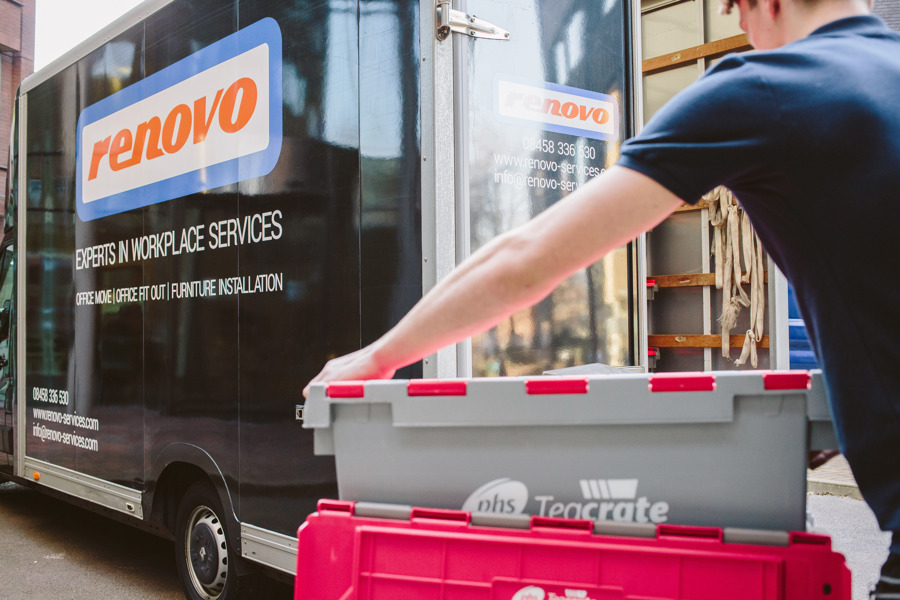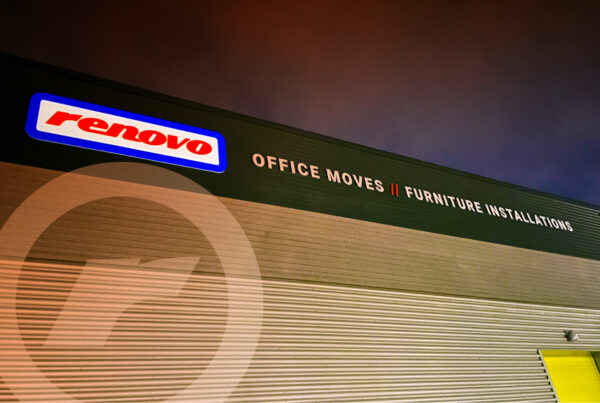
So, your company have decided to up sticks and relocate? Congratulations! Although this is likely a stressful time for all involved, moving office doesn’t have to disrupt your day-to-day business. Rest assured that there are steps that you and your team can take to ensure that your office move goes smoothly. With a step-by-step guide to carry with you at the start of your new journey, Renovo’s very own Danny Rutter advises on what you should do to ensure a smooth-sailing office move.
Early Planning is Key
The key take-away for this step is that you must leave yourself enough time in order to eliminate as many risks as possible. Should one aspect of your move not go as smoothly as you first hoped, having a pre-calculated plan B can help you overcome any obstacles and prevent further obstruction. This step is vital to saving you precious time and money along the way.
Some commercial removal firms recommend that you should start planning as early as 12 – 18 months prior to the physical move; whilst others will claim that three months planning is sufficient. The reality is that no company is the same, and the time it will take to draw out your plan depends on an interminable amount of factors; including how many employees you have; how much furniture and equipment you have to account for; and your budget. In any case, ensure that you begin your plan sooner rather than later.
Try not to fret too much about what exactly your moving plan should look like, or even where to begin. If you are stuck for ideas, start by creating a timeline of dates that you would ideally like to carry out your key steps. If you are stuck for ideas, consider the following:
- What date is best to gather your team to announce the move?
- When should employees be ready to hand their computers over to IT to back up their data?
- How much time will the cleaning crew need to get the building to a sufficient standard, once all belongings have been cleared from the building?
These are all important questions that you should consider before you even go as far as packing away your hole puncher!
Other aspects you should remember to cover in your moving plan are budget, inventory, and key individuals. We advise that you recruit a moving team amongst your employees to assist you in communicating important information about your plan, and to help carry out key tasks related to the relocation.
Share the Good News!
Now that your relocation is set in stone, it is time to share the good news! Of course, the rest of the team should likely be the first to know after all of the management team are on the same page. Communicate clearly and concisely to your colleagues, to ensure that nobody is unclear about key dates and information. Introduce an open-door period where any individual with questions or doubts about the move feels that they can approach you and discuss with you openly.
Set up a communication board on your company intranet with key information or sent out E-Communications detailing such as deadlines for packing and the new office layout. Brief staff to inform them of their duties and to answer questions. Ask staff to take personal items home for safe-keeping.
Once everybody in the office is in the know about this exciting venture, it is time to tell your stakeholders.
The relocation process also presents itself as the perfect opportunity to promote your growth, and to build anticipation of future prospects and opportunities for your company. Share the highlights of your move by uploading fun videos and photos to your company’s social media pages!
When sharing your change of address, reminders should be sent before the move has started, and after you are settled in your new building; to ensure that everybody is fully informed that a) your address shall be changing, and b) you are fully settled and back to business as usual.
When sharing your change of address, here are some important groups to keep in mind:
- Post Directory
- Statutory Bodies (HMRC)
- Accountants
- Service Providers
- Banks
- Insurance Companies
- Suppliers
Assign office move duties
Team work is key to ensuring a successful relocation, especially when you’re handling a large number of employees. In this case, appointing a moving team or project manager to assist moving arrangements and relay communication is going to be a huge help.
Assigning a project manager should be a well thought-out-decision. The person taking on the role should be well organised, a strong communicator and a reliable budgeter. They may instruct staff when to clear their desks, whilst helping every department to pack and label boxes. The moving team should create and check inventories of stock and materials, ready for the project manager to double-check and sign off for the removals company to transport.
It is highly advisable to leave crating and lifting of heavy or expensive items and disassembling/reassembling furniture to the removal firm experts, who have insurance to cover breakages and who are responsible for their own health and safety.
Office move checklist
Breaking down your office move plan into a checklist can help to minimise the seemingly overwhelming and lengthy process into every day, achievable tasks. Forming this checklist, using your office move plan as a reference, will also help you to stay one step ahead so that you are able to lead your team with clear and concise information relating to the move, on a regular basis. Knowing exactly what tasks you are carrying out from week-to-week will also help you to assign the rest of the team their tasks, with enough notice so that they can play their part with minimal diversion from their everyday role.
Advance tasks to include in your office move checklist could be:
Notify current landlord and give notice ☐
Request a detailed floor plan for new office ☐
Research removals companies and request quotes ☐
Book removals company ☐
Order packing materials ☐
Label and boxing up items ☐
Shred unwanted documents ☐
Tasks on the day of the relocation include checking inventories of items moved and placing key staff in the old and new buildings to direct operations. See our full checklist here: https://renovo-services.com/office-relocation-checklist/.
Office Move Budget
The cost of moving offices is dependent on various factors, including how much furniture and equipment you have to transport, how far your new office is from your current one, and how much time you have; to name just a few.
We would highly recommend hiring a specialist removals company to transport your team’s belongings safely from A-Z. Acquire enough quotes from removal firms to compare costs and packages. Remember to ask the important questions, including whether or not they have the expertise to move IT equipment, and whether they are able to provide crates and other storage should you need it. Some removal companies
Before paying anything towards the move, it is advisable to gather estimates for all associated costs so that you can have an estimated cost to compare to your budget. Other bases you may want to consider are:
- Deposit and building costs
- Rent, rates and service charge on new property
- Legal, insurance, consultant fees
- Administration costs (new letterheads, address stationary, marketing material)
- Design and fit-out costs
- Equipment costs (furniture, IT and telecoms)
- Staff relocation costs
- Redirect of post
- Disposal of rubbish, recycling and cleaning
- Dilapidation, making good of the building before vacating
Envision your Layout!
Fortunately, unboxing is one of the final tasks in the removal process. Although, it is certainly not the easiest. It is likely that endless boxes followed by cables, furniture and documents will be there to greet you on your first day in the new office. When it comes to unpacking, an impossible task can often be knowing where to start.
Prior to the move, we would recommend requesting each team to label their boxes and create a coinciding spreadsheet which labels each of the items inside. This will ensure that everybody knows where everything is when it comes to unpacking; and that there is no item unaccounted for.
It is also good practice to make large scale plans of the new office layout before moving in. You can use this to draw-up where individual departments and furniture will be situated. This can also help you to outline which furniture items you may not need to take with you on the move, alternatively allowing you time to donate these items or dispose of them suitably. Alternatively, it may bring to light potential issues with the space. For example, you may find when trying to allocate a space for stationary, that there is not enough room for it. This will allow you to arrange additional storage cupboards before the move, which you can add to your office move checklist.
Once you have an idea of workspaces and where each department will be, discuss this with your staff. Running the floorplan past the team will allow them to communicate any issues they may notice with accessibility or convenience.
*Note: Some removal firms may be able to help with providing CAD plans of your new space.
Minimise downtime
Naturally, a huge concern when relocating is distracting your staff from their everyday roles and a decline in productivity. It is inevitable that some time will be lost throughout the process; particularly around the week of the physical move. So, it is important to plan ahead for this in your moving plan.
It is important to keep in mind that this can be a stressful time for the team as well as the management. Requesting that staff upkeep the everyday workload whilst dedicating their time to the move is a huge ask, and can result in reduced efforts and rushed work. Not to mention, this management style is likely to be unpopular with your staff and can drastically reduce the morale. It is important to reinforce that this change is both exciting and positive for everybody, whilst ensuring that everyone’s need are met.
When reducing downtime, there are a few things you can do to maintain productivity whilst reducing the stress and distractions of the move. Consider the following:
- Allow employees to work from home when their efforts are not needed during the move
- Notify your customers that there may be a delay in communication throughout the move, and provide them with a contact number should an urgent matter arise
- Allocate each department a set period to pack their areas so that they are back to work at the same time. (This is also the perfect opportunity to encourage some team work!)
- Hire external companies to conduct furniture and waste audits to lift some responsibility and pressure off your employees’ shoulders, making certain that all aspects are accounted for
IT Goes First!
Essential IT and electronics come out on top of the list of items that should be relocated and set up in the new office first, to allow for efficiency during the often-time-consuming start-up and configuration process. Prioritizing that these items are the first to be moved allows for damage control measures to be implemented quickly, as unpredictable network and connection errors are always a potential risk.
Before packing away your IT equipment, ensure that all essential data is backed up. You may wish to undergo a pre-move audit, where your company considers the network and application configuration of every PC, along with its related operating systems and software. Allocating IT professionals throughout this period will be useful, to ensure that the network is replicated precisely upon recommission.
For more information or advise on office relocation please contact Danny Rutter on 07553 265 461 or email danny.rutter@renovo-services.com



 Quality Assured
Quality Assured Health and Safety
Health and Safety

